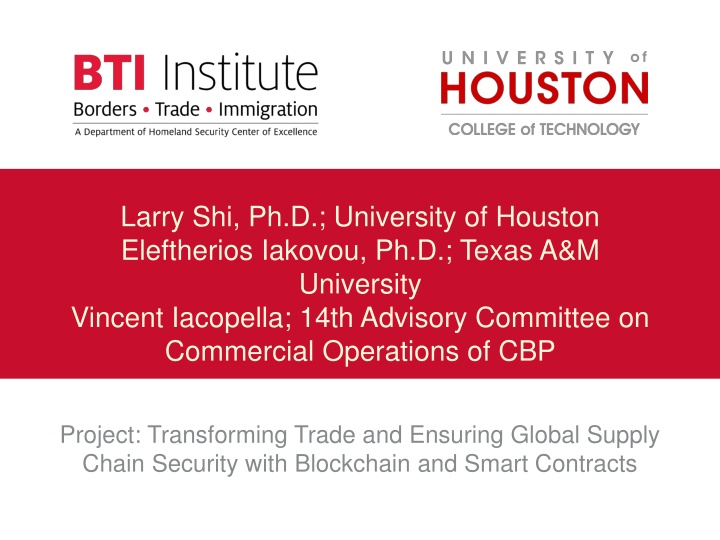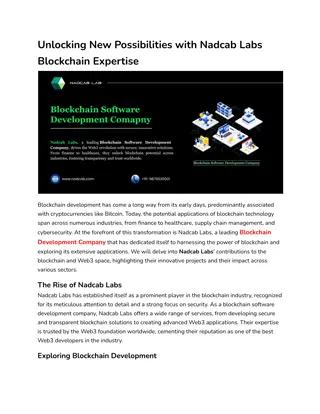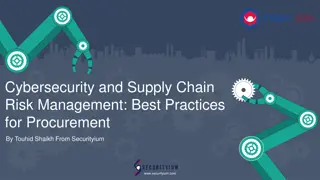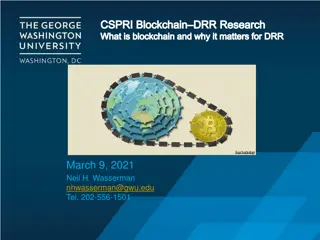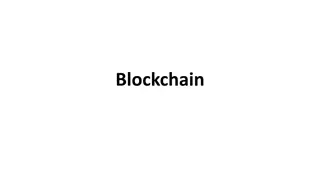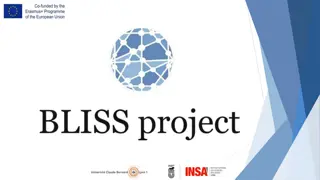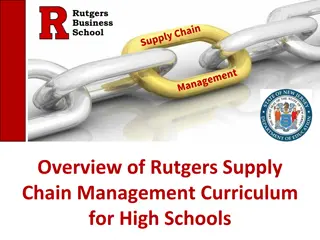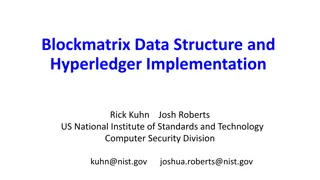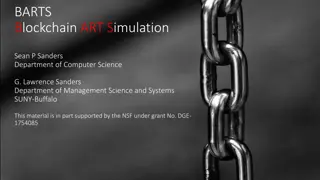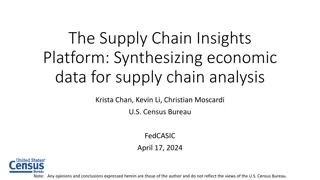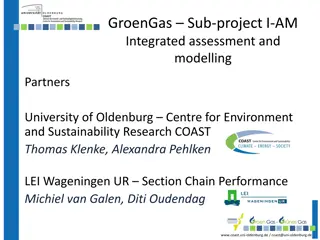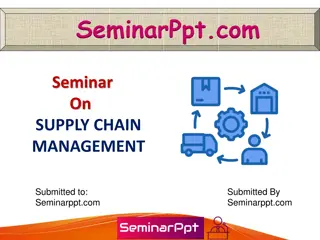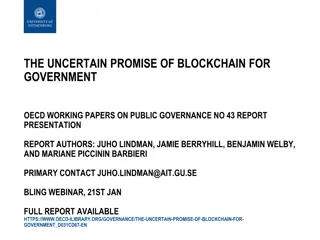Enhancing Global Supply Chain Security with Blockchain Technology
This project focuses on utilizing blockchain and smart contracts to transform trade operations and ensure the security of global supply chains. Led by experts from the University of Houston and Texas A&M University, the project aims to streamline entry data collection processes, assess supply chain risks, and enhance trade compliance through innovative blockchain technologies. The ultimate goal is to provide recommendations and tools for Customs and Border Protection to leverage blockchain effectively, positioning them as leaders in customs operations globally.
Download Presentation

Please find below an Image/Link to download the presentation.
The content on the website is provided AS IS for your information and personal use only. It may not be sold, licensed, or shared on other websites without obtaining consent from the author.If you encounter any issues during the download, it is possible that the publisher has removed the file from their server.
You are allowed to download the files provided on this website for personal or commercial use, subject to the condition that they are used lawfully. All files are the property of their respective owners.
The content on the website is provided AS IS for your information and personal use only. It may not be sold, licensed, or shared on other websites without obtaining consent from the author.
E N D
Presentation Transcript
Larry Shi, Ph.D.; University of Houston Eleftherios Iakovou, Ph.D.; Texas A&M University Vincent Iacopella; 14th Advisory Committee on Commercial Operations of CBP Project: Transforming Trade and Ensuring Global Supply Chain Security with Blockchain and Smart Contracts
Agenda Project Introduction Problem Statement Approach & Methodology Key Accomplishments Transition Pathway Challenges regarding Project Execution Deliverables Wrap-Up Secure Facilitate Ensure
Project Introduction Transforming Trade and Ensuring Global Supply Chain Security with Blockchain and Smart Contracts Project PI and Key Personnel Project Champion: Mr. Vincent Annunziato, Director, Office of Trade, U.S. Customs and Border Protection Larry (Weidong) Shi, Ph.D. University of Houston Lefteris Iakovou, Ph.D.; Lead for Texas A & M University subaward (Logistics and Supply Chain Management) Mr. Vincent Iacopella, Licensed Customs Broker, Trade Co-Chair of the 14th COAC Committee Project Theme Enhance the Ability to Secure and Facilitate Transnational Flows of Goods Project Start and End Date Dec 1, 2018 Nov 30, 2019 Secure Facilitate Ensure
Problem Statement (1/2) Explore innovative opportunities provided by blockchain and other relevant technologies for transforming entry data collection process in order to facilitate the timely analysis of supply chain risk and to ensure trade compliance Conduct feasibility evaluations of simplifying entry data collection by integrating and leveraging commercial blockchain-based E2E) SC ecosystems Identify values and use case scenarios for entry data collection Provide recommendations and knowledge products to CBP components and HSE stakeholders Secure Facilitate Ensure
Problem Statement (2/2) Provide a 30,000 ft. roadmap to CBP so that the agency can leverage the power of blockchain and extend it to the use of blockchain-based applications Support CBP Emerging as a Leader amongst Customs Agencies globally, in utilizing blockchain as a platform for the customs of the future Employing an end-to-end supply chain view of adopting blockchain technology, with a focus on business and commercial process viability Secure Facilitate Ensure
Beneficiaries of the Project Trade Facilitation Trade Law Protecting against illegal imports and collecting customs revenue (e.g., tariffs, fees, and taxes) Office of Trade Import Security Preventing entry of CBRN and related materials, illegal drugs, and other contraband Secure Facilitate Ensure
Beneficiary / End User Profile: Jobs Before goods leave the country of origin, CBP collects initial information from the carrier, importer, freight forwarder and customs broker. Secure Facilitate Ensure
Beneficiary / End User Profile: Desired Gains (1/2) Faster processing Fewer supply chain disruptions Enhanced interagency management and data sharing Reduced labor (e.g., staffing needs, manual or duplicated work) Enhanced transparency and visibility for Global E2E Supply Chain and improved data reliability and quality Added flexibility to the existing revenue collection process Improved targeting capability to identify high risk shipments and importers Secure Facilitate Ensure
Beneficiary / End User Profile: Desired Gains (1/2) Faster processing Facilitation Fewer supply chain disruptions Enhanced interagency management and data sharing Reduced labor (e.g., staffing needs, manual or duplicated work) Enhanced transparency and visibility for Global Supply Chain and improved data reliability and quality Added flexibility to the existing revenue collection process Improved targeting capability to identify high risk shipments and importers Secure Facilitate Ensure
Beneficiary / End User Profile: Desired Gains (1/2) Faster processing Fewer supply chain disruptions Enhanced interagency management and data sharing Reduced labor (e.g., staffing needs, manual or duplicated work) Enhanced transparency and visibility for Global Supply Chain and improve data reliability and quality Security Added flexibility to the existing revenue collection process Improved targeting capability to identify high risk shipments and importers Secure Facilitate Ensure
Beneficiary / End User Profile: Desired Gains (2/2) Border related trade barriers accounts for 44% of trade cost1 1 day less in delivery times => 0.5 % of landed cost of goods2 Each additional day of delay prior to shipment, reduces trade by more than 1%3 Average impact of Supply Chain disruptions4: 107% decrease in Operating Income; 114% decrease in Return on Sales; and 92% decrease in Return on Assets More than 10% reduction on Shareholder Value [1] James E. Anderson and Eric van Wincoop. "Trade Costs". Journal of Economic Literature, 2004. [2] Hummels, David. "Time as a Trade Barrier". 2001. [3] Simeon Djankov, Caroline Freund, and Cong S. Pham. "Trading on Time". The Review of Economics and Statistics, 2010. [4] Hendricks, K. B., Singhal, V., Handbook of Integrated Risk Management in Global Supply Chains , 2012. Secure Facilitate Ensure
Beneficiary / End User Profile: Pain Points Inherent tension between facilitation and security1 Lack of transparency and visibility in the global supply chain2. Access to private databases (e.g., carriers, banks, importers, sellers) Timeliness of data Staffing challenges3 Need for automation and reduction of manual processing of entry data Cost for developing and maintaining IT systems4 Source : [1] CRS-Report-R43014; [2] GAO-17-650; [3] GAO-17-618; [4] GAO-18-271. Secure Facilitate Ensure
Product & Service/Nature of the Project Artifacts including architecture, visual representation/infographics (business flow, architecture, etc.), and illustrations Recommendations and opportunities for PoCs Project report Secure Facilitate Ensure
Approach and Methodology: (1/2) Document As-Is Landscape Map As-Is Process Analyze As-Is Process Evaluate to be Process Suggestions/ Ideas Process Re- design Summary & Report Collect Stakeholder Feedback Brainstorm Stakeholder Meeting Technology Feasibility Pilots/PoCs Literature Review WCO, 2FCC, BiTA, Related Literature Design Science Research (DSR) methodology Secure Facilitate Ensure
Approach and Methodology: (2/2) Document As-Is Landscape Map As-Is Process Analyze As-Is Process Evaluate to be Process Suggestions/ Ideas Process Re- design Summary & Report Collect Stakeholder Feedback Brainstorm Stakeholder Meeting Technology Feasibility Pilots/PoCs WCO, 2FCC, BiTA, Suggestions and Ideas Understand the Problem Re-design Evaluation Report Related Literature Secure Facilitate Ensure
Current Process: (1/2) Trade and Commercial Transaction (offer, purchase order, invoice, etc.) Customs, Brokers and Authorities (power of attorney, certificate of origin, import/export license, sanitary and phytosanitary certificate, etc.) Transportation and Logistics Providers (bills of lading, freight invoice, insurance policy, etc.) Trade Finance and Banks (letter of credit, bill of exchange, etc.) Secure Facilitate Ensure
Current Process: (2/2) Typical Documentation Issued: Manufacturer Sales contract Commercial invoices Term of sale Packing list Forwarder Road permit Export Port Port declaration Manifest Shipment status Import Port Port declaration Manifest Shipment status Importer s Bank/Insurer Letter of credit processing Export Customs Certificate of origin Customs value Export licenses Customs Broker Import manifest Power of attorney Bond Entry summary Importer Purchase order Import Customs ISF Manifests Entry summary Import licenses Exporter s Bank/Insurer Letter of credit Insurance policy Forwarder Bill of lading/airway bill Delivery note Shipment status Loading certificate Carrier Master bill of lading/airway bill Shipment status Secure Facilitate Ensure
Sharing Supply Chain Data over Blockchain Buyer (Importer) & Seller Commercial invoice Purchase order Packing List Term of Sale Banks, Insurance Providers Letter of Credit Processing Insurance Certificate Letter of Credit 3PL, Carriers, Intermodal Operators Bill of Lading Dangerous Good Manifest Loading List Import Manifest Arrival Notice Entry Summary Reconciliation ISF (10+2) Authorities (Export Customs, Import Customs, PGAs) Document Request Advance Ruling Export License Certificate of Origin Documents Messages, Realtime data Public Bulletin, Announcements, Records of Actions (decisions, actions) Secure Facilitate Ensure
Ontology of Entry Data Elements Stakeholders Documents C: create R: read X: include Entry Data Elements Exporting Country and Date Exported Manufacturer ID Number (for AD/CVD Mode of Transportation (MOT Code) and Number /street address Number, Duty, I.R. Tax, and Fees (e.g. Power of attorney (when required by Binding Ruling Identification Number Consolidated shipments authority to Applicable HTSUSA Rate, ADA/CVD Location of Goods-Code(s)/Name(s) (airway bill/bill of lading or *carrier Buyer (or owner) name and address Foreign Trade Zone Designation Seller (or owner) name and address Importer of record number/foreign Ultimate Consignee Name General Order Number (only when trade zone applicant identification Importer of Record Number (IOR) dumping or Countervailing duty Packing list (where appropriate) Consolidator (stuffer) name and Evidence of right to make entry certificate, etc.) when goods are imported on a common carrier. order (ADA/CVD Case Number) Import Date and Line Numbers Broker/Importer Filer Number make entry (if this procedure is Rate, I.R.C. Rate, and/or Visa IT/BL/AWB Number and Code Net Quantity in HTSUSA Units merchandise subject to Anti- and Status Designation (if Description of Merchandise required by the regulations) of premises to be delivered Entered Value, Charges, and Identification number for Duty Free Entry Certificate Container stuffing location Container status messages Ship-to name and address List of Data Elements Required for Entries Textile Category Number (or a copy of the ruling) Non-Dutiable Charges Foreign Port of Lading U.S. Port of Unlading must be actual mfr.) (9808.00.30009 HTS) Consignee number(s) HMF, MPF, Cotton) Carrier Name/Code Total Value Vessel Code/Name Voyage/Flight/Trip Elected Entry Date Manifest Quantity Bond information HTSUSA Number Lease Statement Entry Type Code Country of origin Vessel stow plan Entry Number Gross Weight Relationship regulations) Arrival Date applicable) Port Code utilized) number address Secure Facilitate Ensure
Entry Process Re-Engineering: (1/2) Process Re-design Before After Receiving data at fixed time via CBP portal or ABI in ACE (ISF, manifests, release, entry summary) Data validated after it is received Advance Data Collection Data elements can be retrieved from blockchain proactively right after they are created (proactive data collection at element level instead of waiting for data to be submitted) Validating Data Quality & Reliability Only one version of data on blockchain (no double entry or manual duplication of the same data), data validated by stakeholders when it is created, cross validation among stakeholders involved in a transaction After ISF and manifests are received Risk based Targeting Early targeting (move targeting time to early stage of trade agreement between importer and exporter or trade finance for manufacture), richer data for target decisions, efficient use of enforcement resources Government pays for the cost of developing the system and maintains the IT infrastructure IT Development & Maintenance Embed entry process (data collection, storage, processing) into E2E global supply chain system; Development & upgrade costs are shared among stakeholders (consortium model for blockchain development private public partnership) Secure Facilitate Ensure
Entry Process Re-Engineering: (2/2) Process Re-design Before After Not leveraging blockchain based payment processing and automated settlement Revenue Collection Revenue collection (e.g., fees) can be automated by blockchain-based payment processing and settlement using oracle; For example, an oracle could be programmed to monitor a truck equipped with sensors and trigger payment of duties when the truck crosses the border Post Entry AuditPost entry The re-designed process can enable so called continuous audit, collaborative audit, and automated audit trigger for detecting misstatement/fraud, and verifying compliance (e.g., enabling Customs to better assess the import/export declarations, and applying alternative methods for Customs valuation) Relying on centralized distribution of message set Interagency Data Management PGAs can connect to the same blockchain data sharing system as CBP - real time communications and globally ordered events (e.g., hold) Limited direct visibility/access to IoTs and AI used by the trade side Integration with AI and IoTs The new design can enable seamless integration of CBP data collection process with AI and IoTs as verifiable data sources Secure Facilitate Ensure
Pains Alleviated Tensions between facilitation and enforcement Increased harmony between these two objectives due to improved data sharing environment between trade and customs (better targeting capability, reduced friction at port of entry for legitimate cargo, less direct interaction with customs) Transparency and visibility Improved supply chain data quality, reliability, and visibility Staffing Increased automation and elimination of low level data management tasks (e.g., manual data correction, data re-entering, manual verification or reconciliation), and as a result, efficiency for staffing and workload management Cost Reduced development and IT cost. Data collection and analysis can be embedded into and integrated with the trade process. Development cost is reduced using the consortium model (amortized among stakeholder communities). IT cost can be less due to jointly maintained infrastructure Secure Facilitate Ensure
Gains Created Trade Customs Gains derived from Faster Processing Sharing data early, and improved risk-based targeting * * Enhanced data reliability and quality Elimination of data duplication and cross validation of data accuracy by stakeholders during data creation * * Improved revenue collection Automated fee collection (self-execution of chain code), richer financial data (detecting transfer price, trade-based money laundering, etc.) * More effective use of governmental resources Due to improved data reliability, quality, and timeliness * * Improved timeliness of communication Applying blockchain for messaging and ordered publication (e.g., record of actions) * More effective interagency data management Effective cost sharing Blockchain-based data sharing and messaging support * Consortium-based development model and jointly maintained IT infrastructure * * Secure Facilitate Ensure
Key Accomplishments: Current Status Document As-Is Landscape Map As-Is Process Analyze As-Is Process Evaluate to be Process Collect Stakeholder Feedback Suggestions/ Ideas Process Re- design Summary & Report Brainstorm Stakeholder Meeting Technology Feasibility Pilots/PoCs WCO, 2FCC, BiTA, Steps completed Related Literature Yet to be done Secure Facilitate Ensure
Transition Pathway DHS Components and Governmental Agencies: CBP Office of Trade, CBP Office of Trade Relations, PGAs, BIEC (Border Interagency Executive Council) 21CCF HSE and Trade Community Stakeholders: COAC National Customs Brokers & Forwarders Association of America Air Forwarders Association Global Supply Chain Blockchain Consortia (e.g., BiTA) Pacific Coast Council of Customs Brokers and Freight Forwarders American Association of Exporters and Importers Secure Facilitate Ensure
Challenges Communications with the Private Sector and the relevant Governmental Agencies Temporal Constraints Secure Facilitate Ensure
Planned Items/Next Steps Stakeholder survey on blockchain-based data sharing within trade and with customs covering: Gains, concerns, barriers, adoption, etc. Importers of various sizes and import activity Cost structure analysis Adoption costs in the near term and long term Documentation (brainstorm, re-design, etc.) Investigations (e.g., interoperation, adoption challenges, governance model) Public dissemination (in consultation with BTI, Project Manager, and Project Champion) Secure Facilitate Ensure
Wrap-Up An Overview of the Project Team Mission Goals Timeline Next Steps As per Project Champion, we are on the right track! Exploring the potential of Blockchain to be the platform on which CBP can build upon to emerge as a Global Leader Secure Facilitate Ensure
Thank you for the support ! We look forward to completing the project successfully, while adding value to CBP! Secure Facilitate Ensure
Key References Yotaro Okazaki. Unveiling the Potential of Blockchain for Customs. WCO Research Paper No. 45. June 2018. Emmanuelle Ganne. Can Blockchain Revolutionize International Trade? 2018. Boston Consulting Group. Digital Innovation in Trade Finance: Have We Reached a Tipping Point?, October 2017. Deloitte's 2019 Global Blockchain Survey. Blockchain Gets Down to Business. Deidra Delisser. CBP 21st Century Customs Framework Public Meeting. March 1, 2019. Anthi Tsilimeni-Archangelidi. Blockchain Technology in Supply Chain. Conceptual Redesign of Crude Palm Oil s Trading Business Process. 2018. CBP. Business Rules and Process Document for Trade. CBP. Valuation Encyclopedia(1980 2015). GAO-18-271. GAO-17-618. GAO-17-650. Independent Auditors' Report on U.S. Customs and Border Protection's FY 2014 Financial Statements. Independent Auditors' Report on U.S. Customs and Border Protection's FY 2015 Financial Statements. Hendricks, K. B., Singhal, V., 2012, Handbook of Integrated Risk Management in Global Supply Chains , First Edition, John Wiley & Sons, Inc., Chapter 3, pp. 51-78. Hummels, David. "Time as a Trade Barrier". 2001. Secure Facilitate Ensure
Key References James E. Anderson and Eric van Wincoop. "Trade Costs". Journal of Economic Literature, Vol. 42, No. 3. (Sep., 2004), pp. 691-751. Simeon Djankov, Caroline Freund, and Cong S. Pham. "Trading on Time". The Review of Economics and Statistics, February 2010, 92(1): 166 173. Sean Cao, Lin William Cong, and Baozhong Yang. Auditing and Blockchains: Pricing, Misstatements, and Regulation. Working Draft. 2018. Accenture. How Blockchain Can Bring Greater Value to Procure-to-Pay Processes. Secure Facilitate Ensure
